
It’s Friday afternoon, and you are still at work. Instead of planning an amazing weekend with your family and friends, you are ordering takeout to power through a long night to finish all the work you did not get done this week. It reminds you that you have to find a way to be more productive.
The Productivity Paradox
We live in a world where technology is supposed to make our lives easier, but it does not always work out that way. There is always a new app on the market that promises to make you more productive. You want to finish all your work on Friday and have your weekends free to spend time with family and friends.
So, why not? If an app can make save you time and make you more productive, then it is worth the time and money it takes to set it up. The problem is that it does not always deliver the results for which you hoped. You find yourself trapped in the productivity paradox – you have too many apps, and you are continually switching between them to get your work done.
According to a study published at Slack, app switching can hurt productivity.
This app overload takes a toll on productivity. Fifty-six percent of app users reported that constantly switching between apps and tools makes it harder for them to get work done, and 68% say they spend at least 30 minutes a day just toggling between workplace apps.
Sometimes, the solution you are searching for is not digital, it is analog. You can escape the endless distractions that confront you the moment you open your computer or mobile device by organizing your life and work in an analog journal. For many people, the best way to increase your productivity is to write in a notebook instead of typing into an app.
The Bullet Journal Method
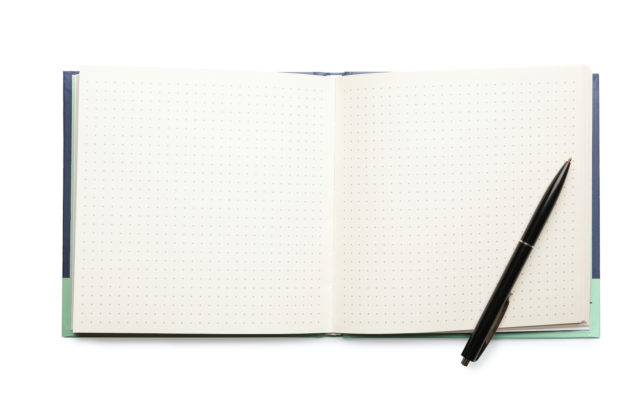
Ryder Carroll, the founder of the Bullet Journal Method, faced a similar dilemma. He wanted a way to keep track of everything that was happening in his life. He wanted a system that was flexible and fast. His solution is called the Bullet Journal Method.
The Bullet Journal Method has developed an active community of devoted practitioners. The popularity of the system led Carroll to write a book on the subject. His book, The Bullet Journal Method: Track the Past, Order the Present, Design the Future, is a New York Times bestseller.
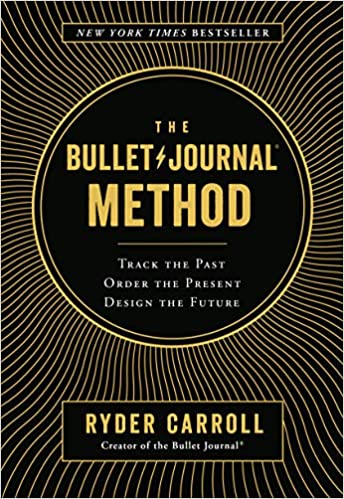
What Is The Bullet Journal Method?
The Bullet Journal Method is an analog system that is designed to do three things:
- Track the past
- Organize the present
- Design the future
The Bullet Journal (or BuJo) is a physical notebook that you write in to track anything that is important to you in your life or work. The official Bullet Journal notebook designed by Ryder Carroll is available for purchase on the Bullet Journal website. However, Bullet Journaling can be done with almost any analog notebook. Personally, I like to use a Leuchtturm 1917 A5 notebook with dot grid pages.
The Bullet Journal is a combination of a calendar, a task manager, and a notebook. It is an organized system for planning, taking notes, and getting work done. The Bullet Journal method can be adapted for almost any purpose.
The Structure Of A Bullet Journal
The system is modular. Each module (or collection) in the Bullet Journal is a way to organize related information.
The Four Core Modules Of A Bullet Journal
1. The Index
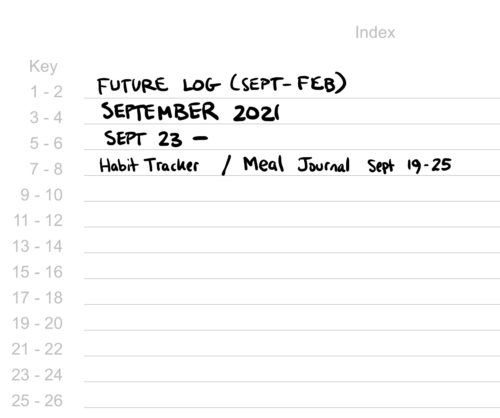
The Index works like a table of contents. It is a list of all the entries in your Bullet Journal and the pages numbers where each entry is located. The Index helps you easily find any content in your Bullet Journal with just a glance.
2. Future Log
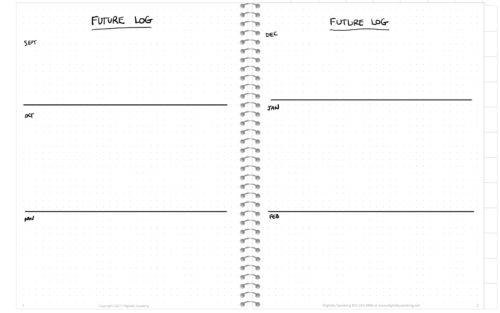
The Future Log is your “time machine” for everything that happens outside of the current month. It is a place to put short reminders about key commitments or scheduled events in the future.
3. Monthly Log
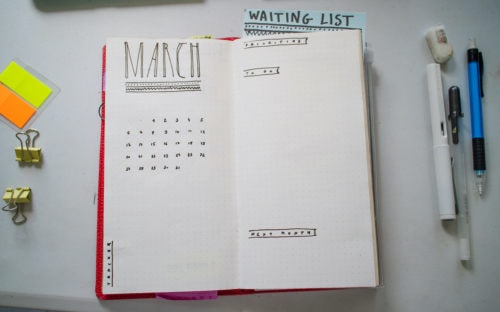
A Monthly Log consists of two elements – a calendar and a task list. The calendar is a one-page at-a-glance reference for both events and tasks. The task list is a place to clear your mind of everything you need to do. Writing it down frees your mind and allows you to get clarity and focus on your priorities for the month.
4. Daily Log
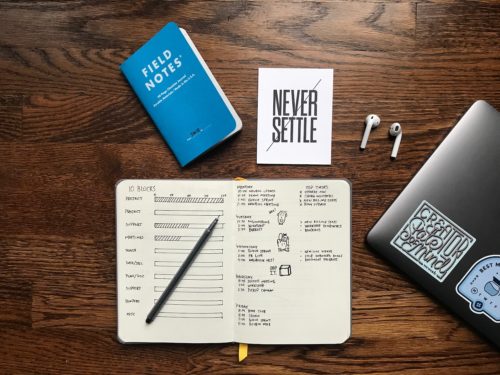
The Daily Log is where you record your tasks, events, and notes as they occur throughout each day.
Bullet Journal Founder, Ryder Carroll explains the basic structure of a Bullet Journal in a video on his website.
Custom Modules (Collections)

The Bullet Journal modules are really just collections of related content. You might have a collection in your Bullet Journal for a work-related project, a collection of related notes, or a set of habits you want to track. Collections can be anything.
For example, if you are planning a family vacation, you may have a collection that includes a packing list, notes with your travel details (including flight numbers and hotel reservations), and names of restaurants you want to try.
You may have a collection for recipes, a collection for habits you are tracking, or inspirational quotes. There is no limit to the number of collections you can put in your journal or restrictions on how they can be arranged. Anything that is useful for your life and work is a legitimate entry for your BuJo.
Common Collections
- Annual, monthly, or weekly calendar
- Project manager
- Task manager
- Meal planning
- Habit tracker
- Weight tracker
- Gratitude journal
- Mental health journal
- Daily diary
- Brainstorming ideas
- Reading list
The Four Components of Rapid Logging
Rapid Logging is the language used when writing in your Bullet Journal. Rapid Logging has four basic elements.
1. Topics
A Topic is a short descriptive title written at the top of each page.
2. Page numbers
Page numbers are added to every page and used in the Index to easily find the content of your Bullet Journal
3. Short Sentences
Short sentences are the entries in your journal that describe a task or record important information.
4. Bullets
Bullets are used in combination with short sentences to define the content as a task, event, or note.
- A task bullet is a simple dot “•” .
- An event bullet is an open circle “○”
- A note bullet is a dash “–”
The standard bullets can always be customized. You can create your own system of bullets that collaborates with how your mind works.
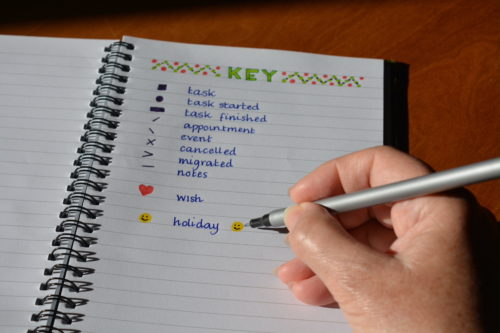
How To Use “Bullets” in Bullet Journaling
Status Indicators
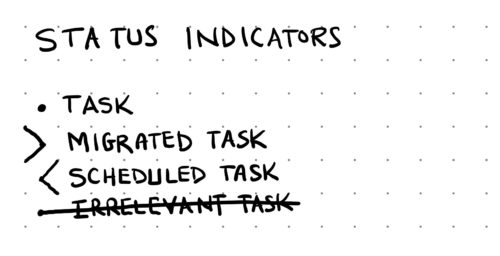
A task bullet in your bullet journal is a powerful organizational tool. It can be used to show the status of a task.
× Indicates a completed task. Congratulations! You did it.
> Indicates a migrated task. It means you did not finish the task, but it is still relevant. A migrated task is moved to a future task list. It may be tomorrow or next week, but you already know when you are going to do it.
< Indicates a scheduled task. A scheduled task is a relevant task that is placed in the future log to be done in a different month.
• Indicates an irrelevant task. It is a task that you have reviewed and determined that it no longer has relevance.
Signifiers
Signifiers are symbols placed to the left of a bullet (for quick visual reference) that provide additional meaning to any bullet. For example, an “*” placed to the left of a task bullet can indicate the task is a high priority. A “!” symbol placed to the left of a note bullet can refer to a great idea you want to consider.
How To Setup Your Bullet Journal
Once you make a decision to give Bullet Journaling a try, it is time to grab your supplies (a pen and notebook are all that is required) and get started with your first BuJo.
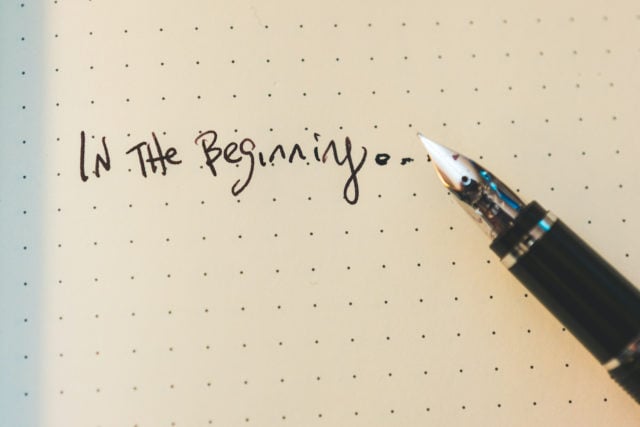
1. Create Your First BuJo Spreads
The Index
Leave the first few pages blank to use as The Index. Each time you create an entry in your Bullet Journal, return to The Index and add the page numbers along with the topic.
The Future Log
Open to the next blank spread (two facing blank pages) after the index and create your Future Log. Divide the spread into six equal quadrants (three on each page). Add the name of the month in the top left corner of each quadrant. This will serve as a future log for the next six months. Don’t forget to put the page numbers at the bottom and record it in your index.
The Monthly Log
Open to the next blank spread after the future log and create your first monthly log. Put the name of the month at the top of each page and add the page numbers at the bottom.
On the first page of the spread, list the numbers for each day of the month. Leave a small margin to the left of the numbers to allow for adding a signifier when it is needed. After the number put the letter initial to represent the day of the week.
The second page of the spread is where you will create a bulleted list of all your tasks for the month.
The Daily Log
Open to the next blank page after the monthly log, and create your first daily log. Add the title for the date and the day of the week (shorthand or abbreviated). Put the page number at the bottom, and you will be ready to start using your Bullet Journal.
Five Ways Bullet Journaling Increases Your Productivity
1. Organize Your Work With Bullet Journal
When you have clarity and focus you are more productive. Using a system like a bullet journal can eliminate “digital distractions” that hurt your overall productivity. Writing down your goals, projects, and daily tasks can increase productivity. Writing is known to improve effective memory recall, critical thinking, and conceptual understanding.
Bullet Journal creates a single distraction-free environment to brainstorm, create project plans, organize your calendar, and manage your daily task list.
Consider using your Bullet Journal to create one or more of the following collections:
- Goal Tracking
- Project Tracking
- Time Tracking
2. Organize Your Health & Fitness in a Bullet Journal
A Bullet Journal is a great place to plan your meals and track your workouts. When you see your diet and exercise in context with your calendar and other commitments, it becomes easier to manage how well you keep track of what you are eating and how often you exercise.
Having a plan for your fitness and an effective way to track it leads to a healthier you…and a more productive you.
Consider using your Bullet Journal to create one or more of the following collections:
- A meal planner
- A food diary
- An exercise tracker
- A Sleep tracker
3. Journal For Mental Health

A Bullet Journal is a great place to capture your thoughts and process your emotional health. Journaling is writing down your thoughts and feelings to understand them more clearly. According to an article published by the University of Rochester Medical Center states that journaling can “help you gain control of your emotions and improve your mental health.”
In fact, at www.bulletjournal.com Ryder Carroll describes Bullet Journaling as “a mindfulness practice disguised as a productivity system.” Improving mental health is baked into the methodology. According to an article published in Positive Psychology there are many work-related benefits to workplace mindfulness including response flexibility, decreased rumination, empathy, affect regulations, increased self-determination, and persistence improved working memory, and more accurate affective forecasting.
When the habit of journaling is built into a system that you are already using on a daily basis it reduces the friction to stick with the habit. As already mentioned, keeping a journal in an analog format minimizes the distractions that come from using a computer or digital device.
You will be more productive if you have a way to deal with stress, depression, or anxiety.
Consider using your Bullet Journal to create one or more of the following collections:
- A gratitude journal
- A mood journal
- A daily diary
4. Habit Tracking

One of the most popular modules for a Bullet Journal is a habit tracker. Tracking your habits can have a significant impact on your productivity. Successful people do not accidentally do the right things every day. They build positive habits.
The well-known book by Dr. Stephen Covey The 7 Habits of Highly Effective People: Powerful Lessons in Personal Change is popular because it works. Habits drive behavior and lead to productive days. Another great resource is the book Atomic Habits: An Easy & Proven Way to Build Good Habits and Break Bad Ones by author James Clear.
Consider using your Bullet Journal to create one or more of the following collections:
- Morning Routine Tracker
- Habit Tracker
- Evening Routine Tracker
5. Keep Track Of Your Best Ideas
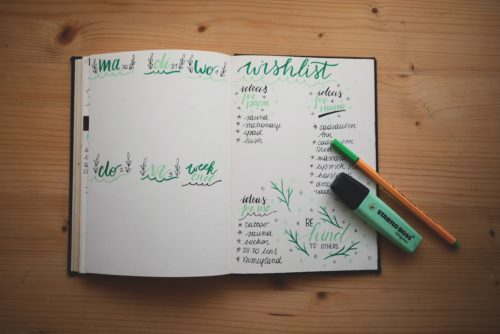
Some of the best ideas will come in unexpected moments of inspiration. The problem is that the ideas only live as long as you can support them in your memory. Eventually, you will forget them unless you write them down.
Bullet Journals give you a way to record your ideas in a trusted system. In this way, your ideas will never be lost. In fact, your Bullet Journal will become a written record of your best thinking on your life and work. Your ideas will always be there for reference and planning.
Consider using your Bullet Journal to create one or more of the following collections:
- Brainstorming journal
- Someday / Maybe journal
- Bucket List
Getting Started With Bullet Journal
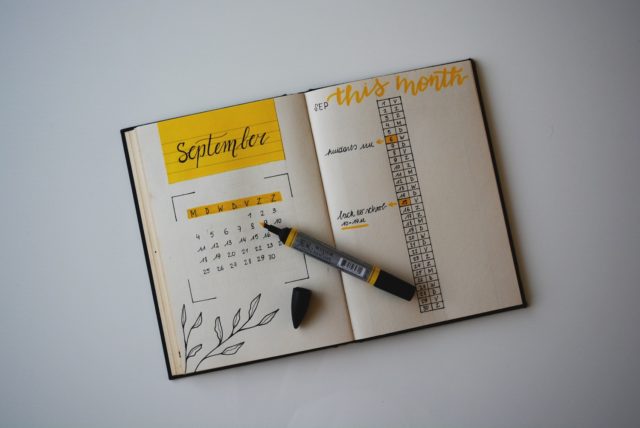
Getting started with Bullet Journaling is relatively easy. It does not require much time or a big budget. All you really need is a notebook and pen.

Thanks for pointing out that bullet journaling is beneficial for us as it helps us to learn to be more productive. My daughter previously shared that she started journaling. Since her birthday is coming up, maybe I can gift her with a custom journal with her initials on it.